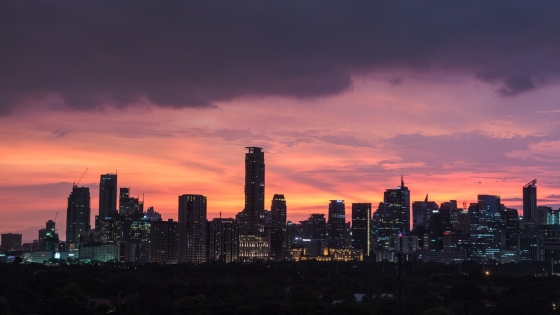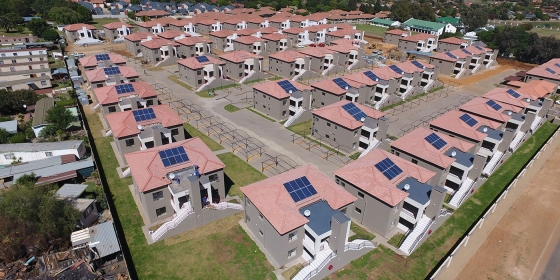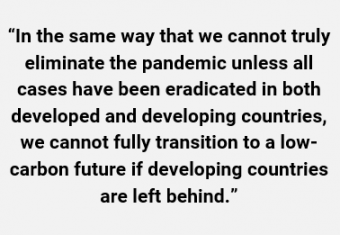Being forced to stay indoors has, despite the challenges, made us appreciate how buildings can protect us from health risks such as COVID-19 but it has also highlighted the importance of green buildings. We know that green buildings are a pathway towards decarbonisation, according to the Intergovernmental Panel on Climate Change (Rogelj et al. 2018, p. 142). Green buildings provide cleaner air and better insulation, ventilation, and lighting for a healthier, more comfortable and productive work-from-home environment (de Jesus 2020). They are energy and water-efficient, lowering our home utility bills, which have ballooned since we vacated our office spaces, based on an Ipsos survey (2020). And, because they use fewer construction materials, they reduce resource extraction, preventing wildlife habitat destruction and biodiversity loss, from which the pandemic is touted to have originated (Stenvinkel et al. 2020). Furthermore, according to the World Green Building Council, “buildings now play a significant role in preventing and controlling the COVID-19 virus” (2020). Indeed, green buildings can support our well-being in the current global pandemic and could play a role in preventing the next one.
However, with world leaders still reeling from the economic shock of COVID-19, it seems that the transition to a low-carbon future has been pushed down the agenda of public policy. The focus has been on bailing out businesses haemorrhaging cash to cushion the impacts of recession, scaffolding our public health systems to keep up with increasing demand, and encouraging responsible, COVID-safe behaviour in communities to manage outbreaks. But, amidst the widespread upheaval and cross-cutting issues we’ve been experiencing comes an unprecedented opportunity to push for the green building agenda.
The Path to a Green Recovery
Churchill once famously said, “Never let a good crisis go to waste” (Gruère 2019), and beyond returning to business as usual, this pandemic has provided new pathways and incentives for reimagining the built environment. At the heart of this global effort is the concept of Build Back Better (BBB), defined by UNDRR as “use of the recovery, rehabilitation, and reconstruction phases after a disaster to increase the resilience of nations” (UN General Assembly 2016, p. 12), which UN Secretary-General António Guterres also highlights as critical to a green recovery from this pandemic (UN Department of Global Communications 2020). He laid out six climate-related actions towards a green recovery in his International Mother Earth Day message (Guterres 2020):
- As we spend huge amounts of money to recover from the coronavirus, we must deliver new jobs and businesses through a clean, green transition.
- Where taxpayers’ money is used to rescue businesses, it needs to be tied to achieving green jobs and sustainable growth.
- Fiscal firepower must drive a shift from the grey to green economy, and make societies and people more resilient.
- Public funds should be used to invest in the future, not the past, and flow to sustainable sectors and projects that help the environment and the climate. Fossil fuel subsidies must end, and polluters must start paying for their pollution.
- Climate risks and opportunities must be incorporated into the financial system as well as all aspects of public policy making and infrastructure.
- We need to work together as an international community.
We see how funding, whether public or private, is a major prerequisite, and this is no mere coincidence. According to a recent McKinsey report, since the pandemic started, more than US$10 trillion has been committed in stimulus packages by the world’s 54 largest economies, representing 93% of global GDP (Cassim et al. 2020, p. 2). Considering that in 2015 the construction sector accounted for up to 13% of global GDP, 7% of total global employment, US$4.5 trillion in investments, and 40% of all energy-related CO2 (Hageneder 2020), then green buildings definitely tick all of the boxes on Mr. Guterres’ list. Therefore, it makes sense to earmark a sizeable portion of the stimulus funds towards investing in more green buildings.
With the role that stimulus packages can play in a green recovery, how about countries in the Global South? Take the Philippines and Indonesia, for example. As of mid-August, the Philippines has surpassed Indonesia with the highest number of COVID-19 cases in Southeast Asia (Walden & Herr 2020). However, both developing countries have large informal sectors and limited resources, resulting in only 10% of GDP allocated for stimulus packages (Cassim et al. 2020, p. 8). With the tremendous effort to raise revenues as both countries enter their first recession since the 1998 Asian financial crisis, are green buildings achievable amidst the pandemic?
Green Buildings for Developing Countries
For the Philippines, Indonesia, and the rest of the developing world, green buildings should not only be viewed as achievable; rather, they should be an imperative if there is any hope of limiting the global temperature increase to 1.5°C above pre-industrial levels. By 2060, the global building sector will double, occurring mostly in emerging markets, where a US$24.7 trillion investment opportunity in green buildings now exists, according to the International Finance Corporation, World Bank Group (IFC 2019, p. 10). Two-thirds of this is in East Asia Pacific and South Asia, where more than 4 billion people are projected to live by 2030 (ibid., p. 15). In developed countries, the urban environment is mostly fully built, and retrofitting is a strategy towards increasing the footprint of green buildings; however, in developing countries, “Build It Right the First Time” seems to make more sense than “Build Back Better”, as emerging cities and urban sprawl remain opportunities for this approach.
While the definition of a green building is flexible and continually evolving, they can be achieved through the “efficient use of energy, water, and other resources” (WGBC 2017). Moreover, IFC’s definition of green buildings also requires green building certification and quantitative reporting of impact metrics (2019, p. 7). Once certified, IFC can provide investment and advisory services for these green building projects. Part of the challenge here is access to this information. To assist with this, IFC created EDGE (Excellence in Design for Greater Efficiencies): an online tool, rating standard, and certification system specifically designed to make green buildings accessible, affordable, and inclusive for developing countries. Requiring 20% efficiency compared to baseline buildings for the most important categories of energy, water, and materials, EDGE is simpler and more straightforward than other green building rating systems. The objective is to enable and encourage the greater participation of property developers and investors in developing countries to transform the market into one where there exists a critical mass of supply and demand for resource-efficient buildings.
In the same way that we cannot truly eliminate the pandemic unless all cases have been eradicated in both developed and developing countries, we cannot fully transition to a low-carbon future if developing countries are left behind. Climate change has not stopped since the pandemic started though we are aware of how human activity impacts on pollution levels, but the COVID-19 pandemic provides opportunities to explore how a truly resilient and sustainable post-pandemic recovery could also be a green and inclusive recovery.


